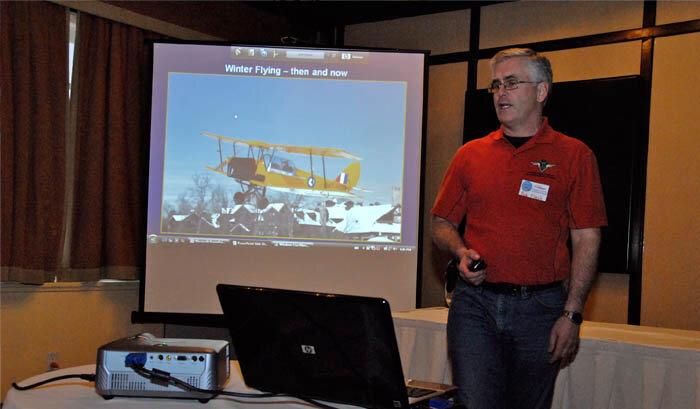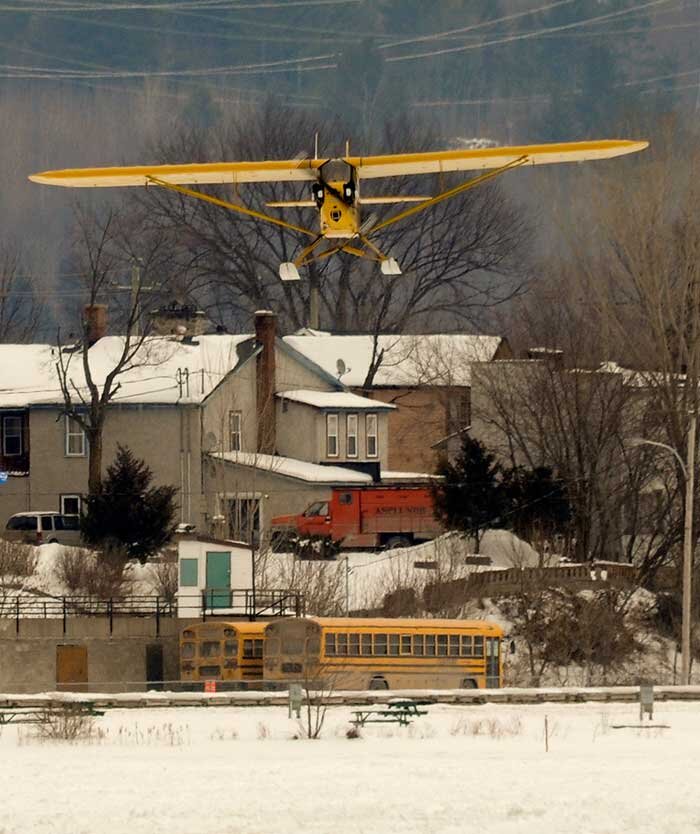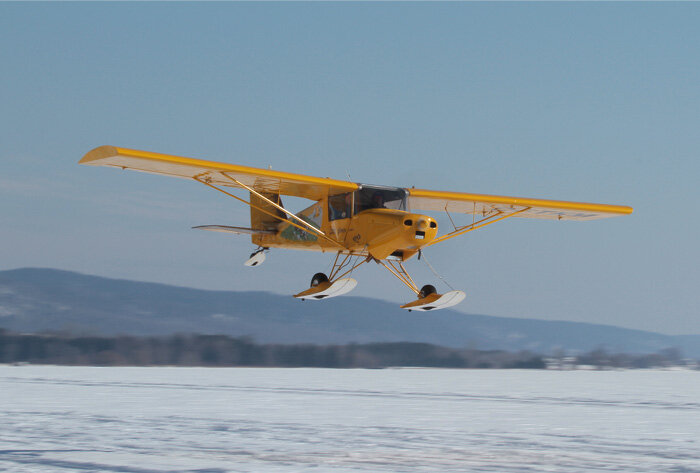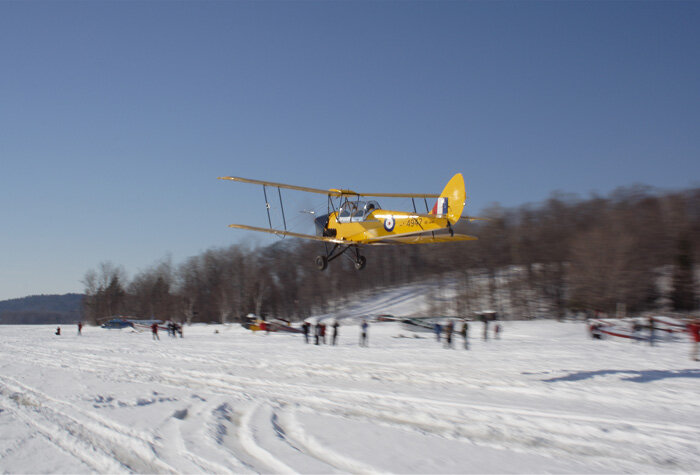YELLOW IN MONTEBELLO
The Ottawa Valley in the 1940s thundered and clattered to the sounds of the yellow training aircraft of the British Commonwealth Air Training Plan. In fact, it was one of the busiest pieces of flying real estate in the country. Along her banks and on the flat plains that form the apron of her flanks, the "Outaouais" was home to many RCAF airfields. They included No. 2 SFTS Uplands with her two relief fields at Carp and Edwards, Ontario, No. 10 EFTS at Pendleton and its relief filed at Limoges, Ontario, No. 13 EFTS at St Eugene and its relief field at Hawkesbury, Ontario and No. 3 Flying Instructors School at Arnprior and its relief landing field at Pontiac, Quebec.
There is no doubt that anyone living in our valley in those days who chose to look skyward on any suitable flying day would find young men in yellow airplanes, single and in small groups, practicing the science and art of flying. It was deadly serious business indeed, but you could lay a weeks wages from the White Swan pulp mill at the foot of Parliament that these boys were having the time of their lives... especially on days of diamond blues skies and cold thick Canadian air. Winter flying, though a trial for the circulation system, can and does create some of the finest flying conditions known to man and bird.
Imagine a beautiful winter's day - feet squeaking under boot, sun so bright you can't even see it and great clouds of white vapour with every happy breath. Imagine a farmer, forking yellow hay to his small herd of steaming cattle in a barn yard along Concession Road One near Jessup's Falls, stopping to look up as a yellow Tiger Moth with a single pilot clatters noisily along following the ice covered road close to the river's edge, hopping over a windbreak of cedars, across the farmer's yard and his oblivious cows, sweeping over the tin roofed barn trailing a short-lived trail of white exhaust.
Imagine now, a few minutes later, a cluster of tar-paper ice-fishing huts to the west of Montebello on Baie de la Pentecôte with a small group of Papineauville citizens standing outside, passing a mickey of Three Aces rum between them. One, looking to the southwest, sees the Tiger Moth rise over the trees along the southern embankment and drop down to 30 feet. He directs the others to look with a jut of his jaw. "Calisse!" They stand in awe as the lone birdman, a pilot from No. 10 Elementary Flying Training School at Pendleton, turns down river toward them. They've seen them before, these “pilotes’, every day it seemed, yet they always were moved at the sight. There were sons of friends who were training too and some who were over there now.
The Tiger Moth pilot waves as he passes and the men wave back. They turn their heads with his passing and follow his progress down the river and round the bend at Île à Roussin. In the cold, hard air, they can still hear him long after he is gone out of sight. "Calisse!" one says again with a low, drawn out, whispering tone of respect and takes a swig from the bottle.
Down river at the elegant and exclusive Seigniory Club at the town of Montebello, imagine a large group of fur clad Montréalers assembling around a snow-filled trough where maple syrup is being made into candy and watching as club employees shovel off a skating rink out on the river. They too are quaffing spirits - but of the finer quality, Johnny Walker Black from silver flasks. They look up together as they hear the Tiger Moth round the point to the west. The scraping sound of shovels stops and the employees shield their eyes as they look into the dazzling and lowering sun. The members stand quietly to let the birdman pass down the river, as if in parade review. Many sons and brothers from Montreal have joined his ranks and they silently pray for his future - one which, they understand from the newspapers, he will be lucky to get back.
One day in the 1940s
The Tiger Moth grows from a backlit silhouette to a bright yellow and cheerful biplane festooned with the red, white and blue of the Commonwealth. He seems to push his blue shadow before and below him, up and over drifted snow dunes and across the frozen water. The pilot is clearly staring over their heads and up the embankment to the log wonder that is their prestigious club. A group of children run parallel to his line of flight for a short distance, waggling their arms outstretched. He briskly waggles his wings in response. The kids tumble into the deep snow with delight and laughter. Following the centre line of the frozen white highway, he makes his way east around the next bend and into his uncertain time to come.
As the Second World War wound down, so too did the training of pilots in the great sweep of the Ottawa Valley. Fewer and fewer yellow birdmen haunted the skies above and the bars below. Cold, crisp days in the winter of 1944-45 were somewhat quieter and somewhat less lively without the sound and sight of looping biplanes and flocking Harvards. It was returning to a quieter place - the place it was before the war.
And so it went. The little yellow biplanes and the earnest young men vanished from the skies altogether. The boys from Montreal and Papineauville came home, but not all. Farmers still brought in their hay and fed their cattle. Ice fishing continued unabated each winter out on the river. The great Seigniory Club became a world class hotel and by the 1990s, little yellow (and other colour) airplanes began appearing out over the frozen river again. The Winter Weekend Rendezvous for Quad City Challenger Ultralight aircraft owners began to meet in this historic place.
Veteran Quebec aviation photographer and Vintage Winger J.P. Bonin can always be counted on to get the perfect angle to tell the bigger story. Here, from a thousand feet up, he shoots the entire scene down at the Ottawa River's frozen banks where the summer time Montebello marina now plays host to ultralights and Canucks. Photo by J.P. Bonin
Yellow on the outside, yellow on the inside. In the warmth of the hotel, Vintage Wings' President Rob Fleck takes attendees through a Powerpoint presentation on the BCATP. Clearly Mary Lee snapped this photo of Dave Hadfield flying up the Ottawa river in front of Montebello and rushed inside to add it to Rob's presentation. Photo by Mary Lee
Related Stories
Click on image
Today, arriving aircraft from Ottawa follow much the same route as did our birdman - passing over farms, and ice fishing huts and over the same stretch of river in front of the world's biggest log cabin - the Fairmont Chateau Montebello. But you could probably count on the fingers of one hand the number of times a Tiger Moth was seen in here in the past sixty years. The Tigers from Pendleton and Arnprior and the Finches and Cornells from St Eugene had long ago been flown to storage depots where they were destroyed or sold off to flying clubs. The few survivors were dispersed across the land.
This past weekend, the Tiger Moth belonging to Vintage Wings of Canada, was readied for flight on the frozen ramp outside of the Gatineau hangar. It was time to return a yellow-winged de Havilland trainer to the skies of Montebello. As part of our 2011 Yellow Wings tribute to the British Commonwealth Air Training Plan, we would kick off the season with a landing on skis on frozen river, followed by a presentation on the BCATP to the participants in the warmth of the Chateau Montebello. Unfortunately, our fully restored Tiger moth skis, which might have passed muster in the war years, were deemed uncertified mods in today's world. The skis would travel overland by car with Vintage Wings President Rob Fleck and the Tiger Moth would take off on wheels piloted by veteran Moth pilot Dave Hadfield.
Though Rob was making a presentation with a focus on BCATP winter operations, having her on wheels was not unauthentic as many air fields across Canada simply rolled their snow into hard pack and operated with wheels. So Hadfield bundled up and squeezed his tall and layered bulk into the Tiger's rear cockpit, while fellow Tiger Moth pilot Blake Reid assisted with an Armstrong start.
Lifting off the sunlit and frozen runway, all Hadfield had to do to navigate to Montebello was slide a kilometre south to the Ottawa river and follow it for 60 miles and it would take him right past the farms, the ice fishing huts and the hotel. As he approached, Rendezvous attendees gathered as they did back in the day to watch his passing - a birdman from the distant past, carried on Yellow Wings. And like so many who came before him who flew that same river, he trailed an faintly detectable exhaust plume of history.
The Winter weekend Rendezvous has always been first and foremost about the Quad City Challenger ultralight and its big enthusiastic family. Here a bright yellow Challenger II plops down onto the deep snow covering the river. Nowadays everyone in any airplane or copter willing to land on the river - some come on wheels and even the odd one will land on floats - are welcome. While the attending aircraft are painted in many different colours, we are just showing you the yellow ones, because, after all, the title of this article is Yellow in Montebello. Photo by Olivier Lacombe
Ben captures another Challenger (C-IGKT) at the moment of touchdown - this one equipped with long range fuel tanks mounted on the wing struts. Photo by Benoit Foisy
Old and new aircraft alike take part in the annual event - here an older Bellanca Citabria alights. Not having a ski on the tail wheel allows for constant braking - a good thing when you want to come to a stop quickly in snow. This particular Citabria has a connection with the old BCATP base at Pendleton where our fictional Tiger Moth pilot was from. Decades ago it was a tow plane for the Gatineau Gliding Club which still operates from the old airfield today. Photo by Olivier Lacombe
Old indeed - a lovely yellow Fleet Canuck, (First flown in 1944) trundles along the Ottawa. Photo by Benoit Foisy
A quirky looking airplane usually has a quirky sounding name and this Interplane Skyboy (C-IDBX) is no exception. It's yellow though. Photo by Benoit Foisy
Another yellow Challenger II C-IREM slides low across the flight line. Photo by Benoit Foisy
The sun shone warm on yellow airplanes this day - all part of the Vintage Wings Plan... OK, maybe we can't claim that. Photo by J.P. Bonin
A Piper J-3 Cub (C-FZIG) settles in with the town of Montebello in the background. Yellow buses qualify for this story. Photo by J.P. Bonin
A bright yellow Denny Aerocraft Kit Fox (C-FPVV) demonstrates why it is so popular, climbing like a homesick angel with JATO. Photo J.P. Bonin
I dunno, but it's yellow. Photo by Benoit Foisy
With the Vintage wings Tiger Moth entering the circuit everyone misses the beautiful take off by a bright red Kit Fox home-built... Red?... that's not yellow. Photo by Benoit Foisy
Prior to his low passes Dave Hadfield floats high in the kind of blue sky you only get when the temperature drops to minus 20 and there is no moisture. Photo by Mary Lee
Benoit zooms into the same high pass to reveal a classic plan form of the de Havilland Tiger Moth Photo by Benoit Foisy
The view from in the cockpit from pilot Hadfield
Dave O'Malley captured the atmosphere of that flight exactly right. It was like stepping back in time. I navigated by following the Ottawa River, and there were hundreds of ice-fishing huts out on the clean snow, some clustered together into little villages. It was a Saturday, and there were kids everywhere, probably out fishing with their grandparents, and as I tootled by I would wave my hand, or the wings, and the rotund little creatures on the ice would wave frantically back. I'm not sure about the "3-Aces Rum", but the pure blue sky, the brilliant sun, and the expanse of untouched white stretching from shore to shore -- and the airplane I was flying -- would have been exactly the same.
The Tiger Moth ran very well. It started on Blake's first hand-powered swing of the prop, and never coughed all day. We'd accomplished the winter mods, baffling the cooling air intake, switching to winter grade oil, and insulating the tank. There was even a heater of sorts, but under the greenhouse canopy in the pure sunlight the solar input was enough to keep the the chill off. I had emergency clothes in the "boot" (it's an English design), but in the cockpit was able to dress in just a few layers. Too bad our skis didn't work out but... next year!
I'd got the word that the snow was bad in front of the resort. There was heavy slush underneath everyplace that wasn't hard-packed by snow-machines. So I had my doubts about being able to land, but I set up to do it anyway. On my first attempt I saw a C-185 on wheels there, and thought, "Well if HE can make it..." , so each time I came around I was slowed right up, tail low, ready to choose a spot, close the throttle, and touch down. But it didn't work out. (On wheels on a rough surface you're a prisoner of ruts. If the tailwheel gets into a rut which then heads away from your track, then so do you! There were plenty of deep ruts.) I looked at it very closely, ready to land each time, but I couldn't find a spot that was quite smooth enough, far enough away from the parked airplanes and the excited crowd.
So, discretion being the better part of valour, I climbed away and headed back to Gatineau.
Lovely, lovely day. Quite a joyous feeling to be handling the sweet little biplane after the winter lay-up. It was impossible to fly straight and level. No aerobatics, no airshows, but lots of happy maneuvering; up on a wingtip at slightest impulse, wandering my way back to Gatineau in anything but a straight line, but always within gliding distance of the ski-do path on the river; the only hard-pack in the whole valley where I could possibly land if the engine quit.
Great day... If that's the way the 2011 Season is going to go, count me in!"
Dave Hadfield, Tiger Moth Pilot
En route to Montebello, in the high clear sunlight, Hadfield enjoys some solar warmth. This image was taken with an HD video camera mounted in the cockpit for the trip... unfortunately it only captured a still image every 5 seconds. To see clips from the trip visit the Vintage Wings Blog and sign up for late breaking news. Photo arranged by Laurie-Anne Smith and Mary Lee
Dave sets up for his first pass over the snow covered river. Throughout the 1940s along this stretch of the Ottawa River, this sort of pass was commonplace with the presence of two nearby Elementary Flying Training Schools - No. 10 at Pendleton and No. 13 at St Eugene - both on the Ontario side. Photo by Mary Lee
With one of Montebello's beautiful out buildings as a backdrop, Hadfield settles her down and steady for a low pass. Photo by Benoit Foisy
And we do mean low. Photo by Benoit Foisy
If it wasn't for the helicopter lurking in the background, this shot could easily be from the 1940s. Photo by J.P. Bonin
A different angle on a different pass with a not so elegant hotel in the background. Photo by Benoit Foisy
Dave sputters down the snowy runway grinning for the cameras. Photo by J.P. Bonin
From the other side of the runway, he seems to be going faster - thanks to Benoit's pan with the airplane. Photo by Benoit Foisy
Any lower and he would be staying for lunch. Photo by Benoit Foisy
Mary Lee shoots Dave Hadfield and the intrepid photographer J.P. Bonin in the same shot. Photo by Mary Lee
The Tiger Moth heads home on a perfect flying day - low winds, cold thick air, sparkling snow and breathless-blue skies. Lucky Mr. Hadfield. Mary captures the thrill everyone had at this rare winter flypast. Photo by Mary Lee































